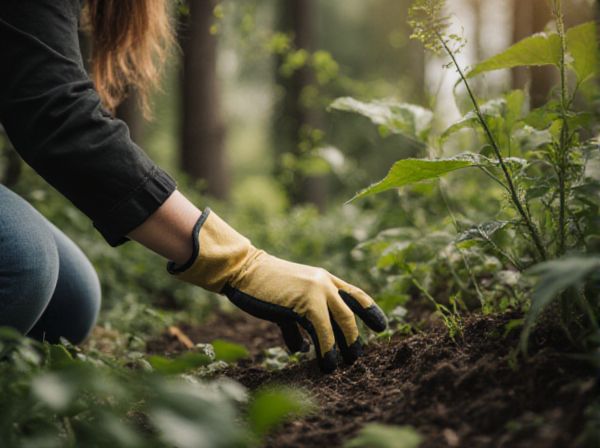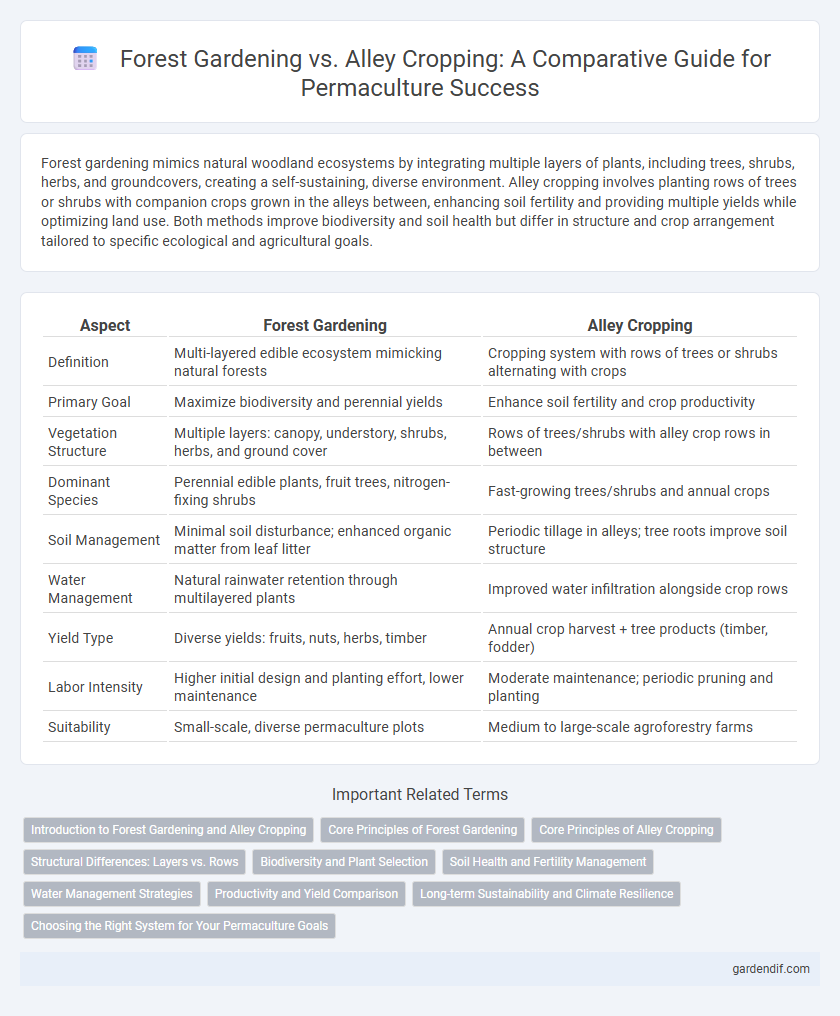
Forest Gardening vs Alley Cropping Illustration
Forest gardening mimics natural woodland ecosystems by integrating multiple layers of plants, including trees, shrubs, herbs, and groundcovers, creating a self-sustaining, diverse environment. Alley cropping involves planting rows of trees or shrubs with companion crops grown in the alleys between, enhancing soil fertility and providing multiple yields while optimizing land use. Both methods improve biodiversity and soil health but differ in structure and crop arrangement tailored to specific ecological and agricultural goals.
Table of Comparison
| Aspect | Forest Gardening | Alley Cropping |
|---|---|---|
| Definition | Multi-layered edible ecosystem mimicking natural forests | Cropping system with rows of trees or shrubs alternating with crops |
| Primary Goal | Maximize biodiversity and perennial yields | Enhance soil fertility and crop productivity |
| Vegetation Structure | Multiple layers: canopy, understory, shrubs, herbs, and ground cover | Rows of trees/shrubs with alley crop rows in between |
| Dominant Species | Perennial edible plants, fruit trees, nitrogen-fixing shrubs | Fast-growing trees/shrubs and annual crops |
| Soil Management | Minimal soil disturbance; enhanced organic matter from leaf litter | Periodic tillage in alleys; tree roots improve soil structure |
| Water Management | Natural rainwater retention through multilayered plants | Improved water infiltration alongside crop rows |
| Yield Type | Diverse yields: fruits, nuts, herbs, timber | Annual crop harvest + tree products (timber, fodder) |
| Labor Intensity | Higher initial design and planting effort, lower maintenance | Moderate maintenance; periodic pruning and planting |
| Suitability | Small-scale, diverse permaculture plots | Medium to large-scale agroforestry farms |
Introduction to Forest Gardening and Alley Cropping
Forest gardening integrates perennial plants, trees, and shrubs in a layered system that mimics natural woodland ecosystems, enhancing biodiversity and soil health. Alley cropping combines rows of trees or shrubs with annual crops grown in the alleys between them, optimizing land use and improving nutrient cycling. Both methods promote sustainable agriculture by increasing resilience and productivity through diverse plant interactions.
Core Principles of Forest Gardening
Forest gardening is based on the core principles of mimicking natural woodland ecosystems by creating layered plant structures, including trees, shrubs, herbs, and ground covers that maximize biodiversity and soil health. This method emphasizes perennial crops and polycultures to sustain long-term productivity and resilience without intensive maintenance. In contrast, alley cropping integrates rows of trees with annual crops in alleys, focusing more on maximizing yield and managing resource competition.
Core Principles of Alley Cropping
Alley cropping integrates rows of trees or shrubs with annual crops grown in the alleys between them, promoting biodiversity and enhancing soil fertility through nitrogen fixation and organic matter input. This system maximizes land use efficiency by combining perennial woody plants that provide shade, wind protection, and nutrient cycling with staple crops, supporting long-term sustainability. Key principles include strategic spacing for light penetration, species selection for complementary growth, and maintenance of soil health through minimal disturbance and organic mulching.
Structural Differences: Layers vs. Rows
Forest gardening features multiple vertical layers of diverse plants, mimicking a natural forest ecosystem with canopy trees, understory shrubs, herbs, and ground covers. Alley cropping arranges crops in linear rows between alleys of fast-growing trees or shrubs to optimize space and enhance soil fertility. The layered design of forest gardening fosters biodiversity and resilience, while alley cropping emphasizes systematic spatial organization for agricultural productivity.
Biodiversity and Plant Selection
Forest gardening maximizes biodiversity by mimicking natural ecosystems with multi-layered plant selection, including canopy trees, shrubs, herbs, and ground covers that support diverse wildlife habitats. Alley cropping integrates rows of nitrogen-fixing trees or shrubs with annual crops, promoting soil fertility and moderate biodiversity but with less structural complexity compared to forest gardens. Both practices enhance ecological resilience, yet forest gardening offers broader plant diversity and habitat variation essential for sustainable permaculture systems.
Soil Health and Fertility Management
Forest gardening enhances soil health by mimicking natural woodland ecosystems with diverse layers of perennial plants, which improve organic matter, nutrient cycling, and microbial activity. Alley cropping integrates rows of trees with annual crops, promoting nitrogen fixation through leguminous species and reducing soil erosion via root systems. Both practices enrich soil fertility but forest gardening emphasizes long-term biomass accumulation, while alley cropping focuses on dynamic nutrient input and protection.
Water Management Strategies
Forest gardening utilizes multilayered plant systems with deep-rooted trees and shrubs that enhance water retention and reduce surface runoff through natural mulch layers. Alley cropping incorporates rows of high-value trees alternating with crops, optimizing water infiltration by maintaining soil structure and promoting efficient water use between plant rows. Both systems strategically manage water through vegetation diversity, root depth variation, and soil cover to improve moisture availability and reduce erosion.
Productivity and Yield Comparison
Forest gardening maximizes productivity by mimicking natural ecosystems with multiple canopy layers, enhancing biodiversity and continuous yield of fruits, nuts, and medicinal plants over time. Alley cropping integrates rows of trees with annual crops, enabling simultaneous production and improved soil fertility through nitrogen-fixing species, boosting short-term crop yields. While forest gardening emphasizes long-term resilience and diverse yields, alley cropping offers higher immediate productivity with effective land-use efficiency for annual and perennial harvests.
Long-term Sustainability and Climate Resilience
Forest gardening enhances long-term sustainability by creating multi-layered ecosystems that mimic natural forests, fostering biodiversity and soil health for climate resilience. Alley cropping integrates rows of trees with crops, improving nutrient cycling and protecting against erosion, which supports adaptive land use under changing climate conditions. Both methods promote carbon sequestration but forest gardening offers greater structural diversity, enhancing ecosystem stability and resilience over time.
Choosing the Right System for Your Permaculture Goals
Forest gardening emphasizes multilayered, perennial plant systems mimicking natural forests, ideal for long-term food production and biodiversity enhancement, while alley cropping integrates rows of trees with annual crops to optimize land use and soil fertility. Selecting the right system depends on goals such as maximizing yield, improving soil health, or enhancing ecosystem services, with forest gardening suited to low-maintenance, diverse yields and alley cropping favoring annual crop rotation and livestock integration. Site conditions, labor availability, and desired outputs should guide the choice between forest gardening and alley cropping within a permaculture design.
Forest Gardening vs Alley Cropping Infographic

 gardendif.com
gardendif.com